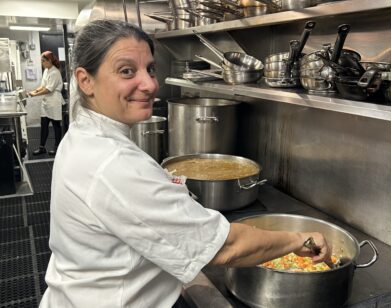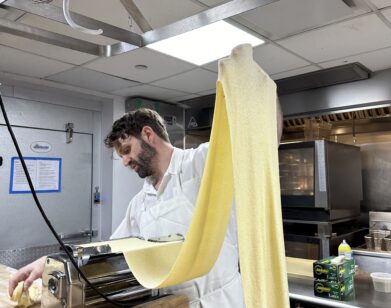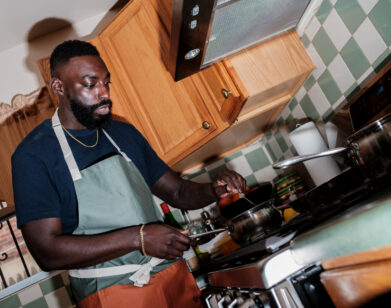LESSON
Chef Jon Kung Gives Us A Lesson In Third Culture Cooking
“I’m seeing a lot of cookbooks that end in -ish. Latin-ish, African-ish,” says Detroit-based chef and internet daddy Jon Kung, who’s mastered a style of cooking that celebrates the experience of living “in between” cultures. His cookbook, Kung Foods, which hit shelves earlier this year, is a love letter to the heart behind the expression,“third-culture cooking,” which historicizes the kinds of fusion dishes that emerged from the scourge of colonization. From house chili oil to Hong Kong-style chicken and waffles, Kung flexes the depth of skill he’s acquired since becoming a self-taught chef and viral TikTok sensation during the pandemic.
Last time we interviewed Kung, for our spring 2022 print issue, he gave us a six-step guide to his viral dumplings (removing your shirt was optional but encouraged). This time, we’re celebrating the launch of Kung Foods and his contribution to PLAY, a cookbook zine, launched this summer by Ludwig Hurtado, featuring queer chefs and artists including Andy Baraghani, Brontez Purnell, and Julia Turshen. To mark the occasion, we invited him to a loft in the middle of Manhattan to show us how to make a five-ingredient Hong Kong-style iced tea. While the water boiled, he clued us into the best third culture restaurants in NYC, the spices he always keeps in his pantry, and which city, once and for all, is home to the best pizza in America.
———
LILY KWAK: So what does the Scottish breakfast tea bring out?
JON KUNG: The Scottish breakfast is a blend of different black teas. It’s a lot more robust than English breakfast tea. So we’re using six bags of that. And what we have here is rooibos tea, which is an African red bush tea. I started putting this in my Hong Kong milk tea blends simply because I was inspired by my grandparents, who lived in South Africa and Johannesburg in Cape Town in the ’90s. My grandmother introduced me to this type of tea when I was younger and I loved it ever since. So, three bags of rooibos tea and we have vanilla extract to go with that. Two drops. And then, this might be puerh. May I open this?
KWAK: Yeah, of course. Those have been waiting for you, honestly.
KUNG: I wish I could read Mandarin. That means small. That’s it. That’s the tweet. And it seems to be inside a little clementine and there’s a little bit of mold on it… In a good way. I do think this might be a fermented tea thing, so I’m going to assume this is what we need and if not, we’re just going to go with it. So Puerh is a fermented black tea. Some of them can get wildly expensive. It’s a strong and pungent flavor. It’s almost earthy, mushroomy. It kind of tastes like the way soil smells and it adds a great amount of body. I would say that is a tablespoon of puerh. Another hallmark of Hong Kong milk tea is the condensed milk. I love condensed milk because it is the ultimate unapologetic source of sweetness. It’s full dairy and it’s full sugar.
KWAK: Is this what goes into bingsu?
KUNG: Yeah, that’s exactly what it is. They put it on top of shaved ice. I generally just boil all the tea together because the condensed milk is so sweet and so creamy, you kind of want everything to get pretty bitter and tannic. The different tastes counteract each other. If something’s too bitter, you just put some sweetness in there. Same with sour. If something’s too tart, a little bit of sugar fixes that right away.
KWAK: This is the cure for my summertime sadness.
KUNG: You literally just put the bags in and boil for five minutes, until it’s completely undrinkable because of how strong it is. And once it’s too offensive to drink, you put it in a cup and then add in enough condensed milk to achieve the color of caramel candy.

KWAK: Mm-hmm. Who was your audience for your book, Kung Food?
KUNG: Is my publisher going to be mad at me if I admit I don’t know? It was assumed that I had a built-in audience because of my TikTok following, so the recipes that I put on there were a mix of difficulties. There was a whole chapter at the end that was dedicated to celebratory recipes: lasagnas, pies, and more complicated things like chicken and waffles which you need special equipment for. But the beginning of the cookbook was more along the lines of condiments and things that you can just stick in the fridge and throw noodles on whenever you want. It was more of a project that allowed people to have the tools and basic components of a lot of Chinese cookery, in the hopes that it would inspire them to make their own kind of third culture food. I was doing things like making dandan lasagna, beef and broccoli pot pie, Hong Kong style chicken and waffles, recipes that were informed by my nostalgia for Hong Kong, but also things that were informed by living in North America, Canada, and Michigan. Three years ago when I was starting to write the book, I don’t think that many people really knew about what it meant to be third culture. But now I’m seeing so many people who embrace it and it’s really nice to see. I’m seeing a lot of cookbooks that end in -ish, Latin-ish, African-ish.
KWAK: How would you describe third culture cuisine in a sentence?
KUNG: Third culture cuisine is fusion that is informed by a lived experience. It’s very, very much rooted in who you are as a person. And it’s my way of celebrating the fact that I was raised in between cultures instead of when I was younger and I was embarrassed that I was neither Chinese enough or American enough.
KWAK: It celebrates the in-between. Are there other third culture chefs that inspire you?
KUNG: Oh yeah. I love Eric Kim, at the New York Times.
KWAK: He does fun ramen gochugang recipes.
KUNG: Yeah, that’s him. He always looks like he just woke up from an amazing nap. And Rick Martinez, but more recently, Frankie Gaw. His book is like a Taiwanese American book. And then Yewande [Komolafe], the name of her book is My Everyday Lagos. And Khushbu Shah–Amrikan is a Desi third culture cookbook and very much along the same lines of what I’m doing. She also has a lasagna recipe, but hers is a saag paneer lasagna. It’s really good.
KWAK: Do you know Lucas Sin?
KUNG: Oh my gosh, he’s so cool. Oh, also Bonnie’s. The chef Calvin Eng has a book coming out. In his restaurant he has a Char Siu McRib, which is amazing. But they got a cease and desist letter from McDonald’s, so they don’t call it that anymore. Okay, it should smell like this. Go ahead, take a smell.
KWAK: Wow. It smells like a potion my mom made me when I was sick.
KUNG: Super medicinal, herbaceous, but it’s very much rooted in tea. And we’re just going to add just a tiny bit of vanilla extract to it. Better to do it after you’ve taken it out of the pot because vanilla extract is mostly alcohol and you don’t want it to cook out. Also, vanilla extract is fucking expensive. A little bit of pandan extract would also work. If you can find that.
KWAK: What is pandan?
KUNG: Pandan is a leaf that is very common in Southeast Asian cooking. It makes everything green. If you see green desserts and cakes and stuff at a Balinese or Indonesian restaurant, that’s probably pandan. I always say it’s like if vanilla had a master’s degree in art history. This piping hot cup of tea is exactly what we need on a sweltering day like today. It’s also really good over ice, as it would be since it’s the base tea for a lot of classic boba teas. I would not be shy with this stuff because if you’re going to do this, you’re not trying to be healthy anyway, so you might as well fully enjoy it.
KWAK: So that’s like one and a half tablespoons of condensed milk?
KUNG: Yeah. This is a good color. It could go lighter, depending if you like it sweet. It almost dries your mouth with all the tannins from the tea. That’s how bitter it is. It’s beautiful because it’s an old style of preparing tea that could only have happened with imperialism. It’s like the curry of tea. British people brought in their condensed milk and had their preferences for tea. Chinese people in Hong Kong have adapted it into their own. Third culture cuisine, even though it might be a recent name, is a product of globalization and colonization. In the case of our generation, it’s informed by lived experience, but when it started it was informed by survival.
KWAK: I was scrolling through Instagram and I also saw you using Spam. There’s so many Spam dishes made out of when the West was colonizing Korea.
KUNG: The story of Korean Army Stew is brutal and so harsh and terrible, but it’s turned into this comfort food that is the favorite of so many Korean people. But it started off as literally the most inhumane and terrible way that one group of people saw another people.
KWAK: Okay, a couple questions for you. What are the go-to Detroit food spots?
KUNG: Everybody needs to try Detroit-style pizza. I will say this with my whole chest in the middle of New York, that Detroit style pizza is superior.
KWAK: What makes it superior?
KUNG: Do you like focaccia?
KWAK: I love focaccia.
KUNG: Detroit style pizza is like pizza on a really good focaccia. It is a deep dish pizza with a crispy and airy crust. I know there are a couple of Jets locations here. They’re a Detroit style pizza chain and they are very reliably good.
KWAK: Okay, last question; I just started cooking and I’m trying to use the same seasonings I can remix for different dishes. What are some versatile ingredients everyone needs in their kitchen?
KUNG: Curry powder. It’s one of those things that you can add to butter, mayo, all sorts of things, and it immediately just enriches the dish. All you have to do is remember that curry powder needs to be cooked, so you can fry it in butter first or ghee or oil or whatever. That will activate it, and then you add it to your mayonnaise and eat it with fries or top it on pizza or something like that. Another thing is Chinese five spice. I’ve always been a huge proponent of it, and I think it’s very under-appreciated when it’s used in sweet things. Not only do you need Chinese five spice to cook a lot of Cantonese food, but you can add it to Swiss Miss hot chocolate, and suddenly your hot chocolate tastes fancy and expensive. It adds such a punch to any kind of chocolatey thing.












